Fluorophores for the Blue (488 nm) Laser

- On This Page
- SBB580
- SBB615
- SBB675
- SBB700
- SBB765
- SBB810
Overview
The blue laser is versatile due to its ability to excite both FITC (and similar fluorophores), PE, and PE tandems. PE is also excitable by the 561 nm laser and so PE based fluorophores appear on both lists. However, as PE is maximally excited at 546 nm, where possible it is advisable to use the 561 nm laser to get the maximal signal and to reduce spillover and therefore compensation. This also frees up space on the blue laser for additional fluorophores.
Table 1. 488 nm excitable dyes for flow cytometry.
Fluorophore |
Ex Max |
Em Max |
Brightness |
5 laser ZE5 Filter |
3/4 laser ZE5 Filter |
Similar |
|---|---|---|---|---|---|---|
|
Alexa Fluor 488 |
495 |
519 |
3 |
525/35 |
509/24 |
FITC, DyL488, BB515 |
|
FITC |
490 |
525 |
3 |
525/35 |
509/24 |
FITC, BB515 |
|
PE |
496 |
578 |
4 |
593/52 |
583/30 |
SBB580 |
|
StarBright Blue 580 |
475 |
582 |
4 |
593/52 |
583/30 |
AF532, PE |
|
StarBright Blue 615 |
475 |
612 |
4 |
593/52 |
615/24 |
PE-Dazzle594, PE-CF594 |
|
PE-A647 |
496 |
667 |
3 |
692/80 |
692/80 |
PE-Cy5, SBB675 |
|
PE-Cy5 |
496 |
667 |
4 |
692/80 |
692/80 |
PE-A647, SBB675 |
|
StarBright Blue 675 |
476 |
675 |
5 |
692/80 |
692/80 |
PE-Cy5, PE-A647 |
|
PerCP |
490 |
675 |
2 |
692/80 |
692/80 |
|
|
PE-Cy5.5 |
496 |
695 |
4 |
692/80 |
692/80 |
|
|
StarBright Blue 700 |
473 |
703 |
5 |
692/80 |
692/80 |
BB700, PerCP-Cy5.5 |
|
StarBright Blue 765 |
476 |
764 |
4 |
750LP |
750LP |
PE-A750, PE-Cy7 |
|
PE-A750 |
496 |
779 |
3 |
750LP |
750LP |
PE-Cy7, SBB765 |
|
PE-Cy7 |
490 |
785 |
4 |
750LP |
750LP |
PE-A750, SBB765 |
|
StarBright Blue 810 |
477 |
802 |
4 |
750LP |
750LP |
|
A488 (ex max 495, ex max 419)
With similar fluorescence properties to FITC, Alexa Fluor 488 is not compatible with FITC or GFP. However, as it is brighter and more photostable, it is a great alternative, especially for intracellular staining and in fluorescence microscopy.
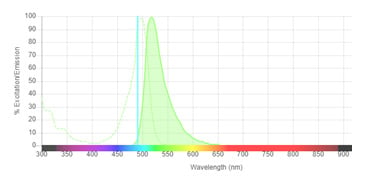
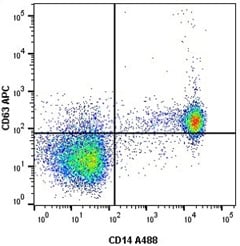
Fig. 1. Alexa Fluor 488 staining. Human peripheral blood was stained for CD63 (MCA2142APC) and CD14 (MCA1568A488) after blocking with 10% human serum. Data acquired on the ZE5 Cell Analyzer and gated on live single mononuclear cells.
FITC (ex max 490, em max 525)
FITC, a derivative of fluorescein, was one of the first fluorophores to be conjugated to an antibody. It is sensitive to pH and photobleaching with mid range brightness. Due to similar excitation and emission characteristics, it is not compatible with Alexa Fluor 488 or Green Fluorescent Protein (GFP).
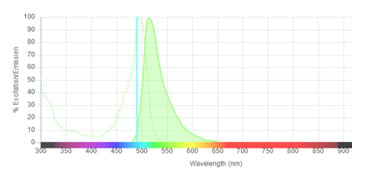
PE (ex max 496, em max 578))
Phycoerythrin is a member of the light harvesting phycobiliprotein found in red algae. PE is one of the brightest fluorophores, but is rapidly photobleached, as are tandems of PE, making them unsuitable for fluorescent microscopy applications.
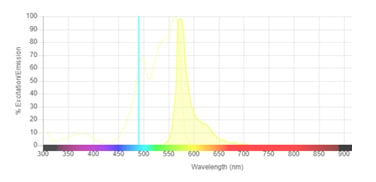
StarBright Blue 580 Dye (ex 475, em 582)
StarBright Blue 580 Dye is a new, proprietary, fluorescent nanoparticle from Bio-Rad. Maximally excitable by the 488 nm laser and emitting at 580 nm, this dye is brighter than Alexa Fluor 532 and as bright as PE from the 488 nm laser, without the 561 nm excitation, making it an excellent choice for use in multicolor panel building.
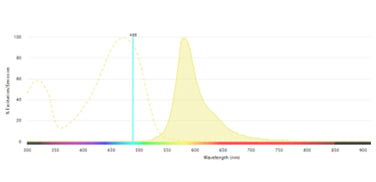
StarBright Blue 615 Dye (ex 475, em 612)
StarBright Blue 615 Dye is a new, proprietary, fluorescent nanoparticle from Bio-Rad. Maximally excitable by the 488 nm laser and emitting at 611 nm, this dye is brighter than both PE-Dazzle594 and PE-CF594 when excited by the 488 nm laser. In addition, SBB615 shows reduced excitation by the 561 nm laser, allowing additional multiplexing. As it is not a traditional tandem dye it is more stable, being resistant to spectral changes over time making it an excellent choice for use in multicolor panel building.;
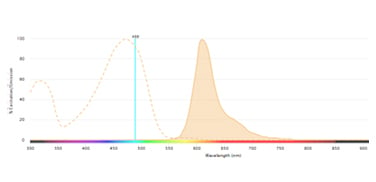
PE-A647 (ex max 496, em max 667)
PE-A647 is a tandem dye of PE and Alexa-Fluor 647, exclusive to Bio-Rad. It cannot be used with PE-Cy5 as it has similar excitation and emission characteristics. However, it is a good alternative as it does not exhibit the nonspecific binding to Fc receptors, particularly on monocytes, seen with PE-Cy5.
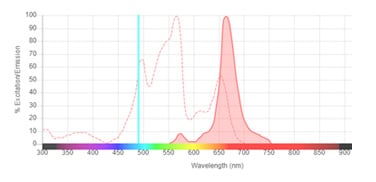
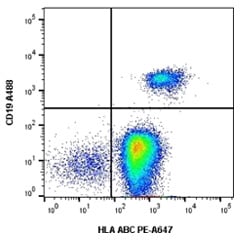
Fig. 2. PE-Alexa-Fluor 647 staining. Human peripheral blood stained with HLA-ABC (MCA81P647) and CD19 (MCA1940A488) after incubation with 10% human serum to detect B cells. Data acquired on the ZE5 Cell Analyzer.
PE-Cy5 (ex max 496, em max 667)
PE-Cy5 is a tandem of PE and cyanine 5. It cannot be used with PE-A647 or APC due to similar emission spectra. Cy5 in this tandem has been shown to bind nonspecifically to Fc receptors.
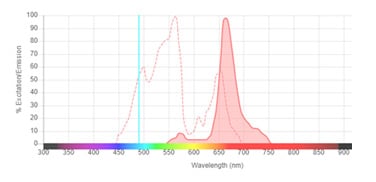
StarBright Blue 675 Dye (ex 476, em 675)
StarBright Blue 675 Dye is a new, proprietary, fluorescent nanoparticle from Bio-Rad. Maximally excitable by the 488 nm laser and emitting at 675 nm, this exceptionally bright dye is brighter than PerCP-Cy5.5 and BB700 with reduced spillover and is even brighter than PE-Cy5 when excited by the 488 nm laser. On the ZE5 Cell Analyzer, SBB675 cannot be used with SBB700 due to both maximally emitting into the 692/80 filter.
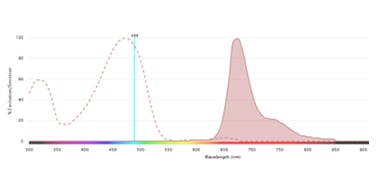
PerCP (ex max 490, em max 675)
PerCP (Peridinin-Chlorophyll-Protein) is a fluorescent protein complex found in dinoflagellates, which exhibits a large stokes shift, giving extra options on the blue laser.
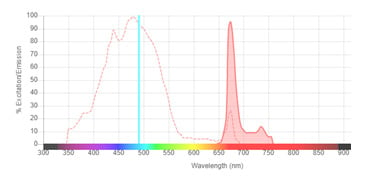
PE-Cy5.5 (ex 496/em 695)
PE-Cy5.5 is a tandem of PE and cyanine 5.5 which has been shown to have less nonspecific Fc receptor binding.
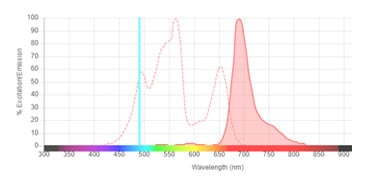
StarBright Blue 700 Dye (ex 473, em 703)
StarBright Blue 700 Dye is a new, proprietary, fluorescent nanoparticle from Bio-Rad. It can be detected using the same filter set for PerCP-Cy5.5 and BB700, however as it is brighter and has reduced cross-laser excitation, it is a superior alternative. Because of similar spectral properties, it cannot be used with PerCP-Cy5.5 or BB700 at the same time. Find out more about StarBright Dyes.
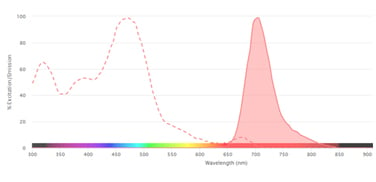
StarBright Blue 765 Dye (ex 476, em 764)
StarBright Blue 765 Dye is a new, proprietary, fluorescent nanoparticle from Bio-Rad. Maximally excitable by the 488 nm laser and emitting at 763 nm, this exceptionally bright dye is brighter than PE-Cy7 when excited by the 488 nm laser and as it is not a traditional tandem is not prone to instability leading to changes in its spectra. On the ZE5 Cell Analyzer, SBB765 can be used with PE-Cy7 if PE-Cy7 is excited by the 561 nm laser, providing more choice when building multicolor panels.
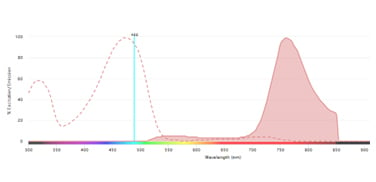
PE-A750 (ex-max 496, em-max 779)
PE-A750 is a tandem dye of PE and Alexa-Fluor 750, exclusive to Bio-Rad. It cannot be used with PE-Cy7 as it has similar excitation and emission characteristics. However it is a good alternative as it is more stable and not as sensitive to paraformaldehyde fixation as PE-Cy7.
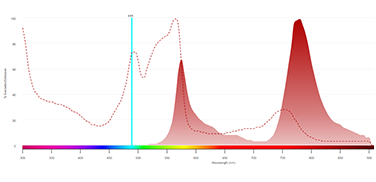
PE-Cy7 (ex 496/em 785)
PE-Cy7 is a tandem of PE and cyanine 7. PE-Cy7 is very photosensitive and can degrade with paraformaldehyde fixation. It cannot be used with PE-A750 due to similar emission spectra.
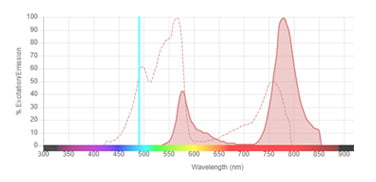
StarBright Blue 810 Dye (ex 477, em 802)
StarBright Blue 810 Dye is a new, proprietary, fluorescent nanoparticle from Bio-Rad. Maximally excitable by the 488 nm laser and emitting at 808 nm, this exceptionally bright dye is brighter than PE-Cy7 when excited by the 488 nm laser. On the ZE5 Cell Analyzer, SBB810 cannot be used with SBB765 as they both maximally emit into the 750LP filter.
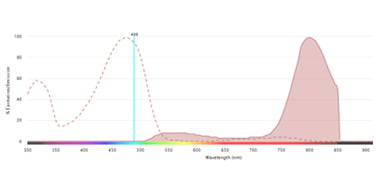
Fluorophores by Laser
Bio-Rad stocks a selection of different fluorophores that are usable with a range of lasers. Details of which fluorophores are best suited to which lasers can be found on our Fluorophores for Flow Cytometry page.
For more information about fluorophores and immunophenotyping, refer to our flow cytometry resources below.





